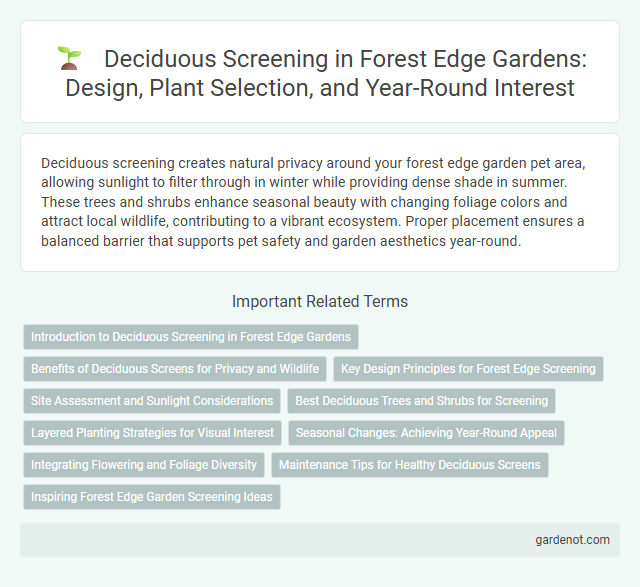Deciduous screening creates natural privacy around your forest edge garden pet area, allowing sunlight to filter through in winter while providing dense shade in summer. These trees and shrubs enhance seasonal beauty with changing foliage colors and attract local wildlife, contributing to a vibrant ecosystem. Proper placement ensures a balanced barrier that supports pet safety and garden aesthetics year-round.
Introduction to Deciduous Screening in Forest Edge Gardens
Deciduous screening in forest edge gardens offers seasonal privacy and visual interest by using trees and shrubs that shed their leaves annually, allowing sunlight in winter while providing shade in summer. Common species for this purpose include maples, birches, and oaks, which thrive in temperate climates and support local wildlife habitats. This natural barrier enhances biodiversity while maintaining airflow and light penetration, making it a sustainable option for garden design.
Benefits of Deciduous Screens for Privacy and Wildlife
Deciduous screening provides seasonal privacy by blocking views during growing months while allowing sunlight in winter, enhancing garden comfort and energy efficiency. These screens support local wildlife by offering habitat and food sources such as flowers, fruits, and shelter for birds and insects. Incorporating deciduous plants along a forest edge garden balances human privacy needs with ecological benefits, promoting biodiversity.
Key Design Principles for Forest Edge Screening
Deciduous screening at the forest edge uses strategically selected tree species such as maples, oaks, and birches to create seasonal visual interest while enhancing biodiversity. Key design principles emphasize layered planting to ensure year-round privacy, appropriate spacing for healthy growth, and integration of native understory plants to support local wildlife. Effective forest edge screening balances aesthetics and ecological benefits, providing a dynamic natural barrier that evolves through the seasons.
Site Assessment and Sunlight Considerations
Deciduous screening at a forest edge garden requires careful site assessment to determine soil type, drainage, and microclimate conditions that support healthy tree growth. Sunlight considerations are crucial, as these trees lose leaves seasonally, providing shade in summer and allowing sunlight to penetrate in winter, enhancing garden biodiversity and energy efficiency. Proper placement enhances privacy while maintaining ecological balance with native flora and fauna.
Best Deciduous Trees and Shrubs for Screening
Deciduous screening in forest edge gardens benefits from species like Quercus rubra (Northern Red Oak) and Betula papyrifera (Paper Birch) due to their dense foliage and seasonal color changes. Shrubs such as Cornus sericea (Redosier Dogwood) and Viburnum dentatum (Arrowwood Viburnum) provide effective understory screening with attractive flowers and wildlife habitat. Selecting native deciduous trees and shrubs enhances biodiversity while maintaining visual privacy and aesthetic appeal throughout the growing season.
Layered Planting Strategies for Visual Interest
Deciduous screening at the forest edge garden benefits from layered planting strategies that combine diverse tree and shrub species to enhance visual texture and seasonal interest. Incorporating multiple plant heights and varied foliage shapes creates a dynamic, naturalistic barrier that changes color and density throughout the year. This approach maximizes biodiversity, supports wildlife habitats, and delivers aesthetic appeal by blending contrasting leaf forms and seasonal growth patterns.
Seasonal Changes: Achieving Year-Round Appeal
Deciduous screening plants in a forest edge garden provide dynamic seasonal interest by transforming foliage color and density throughout the year, enhancing aesthetic appeal from spring blooms to vibrant autumn hues. These trees and shrubs shed leaves in winter, allowing sunlight to penetrate and warm garden spaces while maintaining privacy in warmer months. Selecting species with staggered leaf change timing ensures continuous visual texture and habitat diversity across seasons.
Integrating Flowering and Foliage Diversity
Deciduous screening in forest edge gardens enhances privacy and seasonal interest by integrating diverse flowering and foliage species such as viburnums, dogwoods, and serviceberries. These plants provide a dynamic mix of colorful blooms in spring and summer alongside vibrant autumn foliage, supporting biodiversity and attracting pollinators. Selecting species with staggered flowering times and varied leaf textures optimizes visual appeal and ecological function throughout the year.
Maintenance Tips for Healthy Deciduous Screens
Regular pruning of deciduous screening trees promotes vigorous growth and maintains optimal density for privacy. Applying mulch around the base conserves moisture and suppresses weeds, supporting root health throughout seasonal changes. Monitoring for pests and diseases early allows for timely treatment, ensuring the longevity and vitality of the screening foliage.
Inspiring Forest Edge Garden Screening Ideas
Deciduous screening in a forest edge garden creates dynamic seasonal interest while providing privacy and habitat for wildlife. Incorporating species like birch, dogwood, and maples offers vibrant fall colors and dappled shade, enhancing the garden's natural beauty. Using layered plantings with shrubs and understory trees maximizes visual appeal and ecological benefits at the forest boundary.
Deciduous screening Infographic

 gardenot.com
gardenot.com